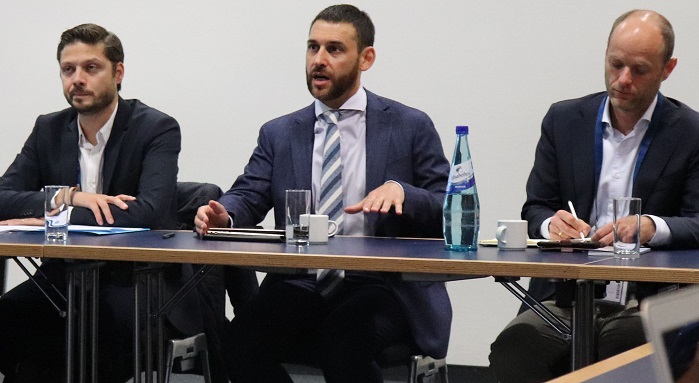Opinion

Associations launch joint circular economy manifesto
Adrian Wilson


Pictured announcing the manifesto during the recent Techtextil/Texprocess exhibition in Frankfurt (left to right) are: Jérome Pero, secretary general, FESI, Mauro Scalia, director of sustainable businesses, Euratex and Matthijs Crietee, secretary general, IAF. © Innovation in Textiles
Euratex, the European Apparel and Textile Confederation and four other industry organisations have published a new joint manifesto on what is required to establish a truly circular economy in textiles.
The manifesto has been issued by Euratex with the Federation of the European Sporting Goods Industry (FESI), Global Fashion Agenda (GFA), the International Apparel Federation (IAF) and the Sustainable Apparel Coalition (SAC).
“This manifesto represents the start of a groundbreaking, international, industry-wide collaboration and indicates that our organisations agree that urgent action is required,” said Mauro Scalia, director of sustainable businesses at Euratex “As a diverse group representing the global nature of the industry, we have joined forces to achieve lasting change. We are willing and committed to supporting the journey to co-develop a European vision for textiles in a circular economy.
In the coming months, the organisations will expand on the following issues and key points:
Framing the Issue
- Circularity should be considered as a means to achieve climate and resource protection and not an end in itself.
- If any part of the loop is broken, a circular economy cannot function. A holistic approach to circular economy in textiles must therefore go beyond waste and recycling and include measures to incorporate better design and materials.
- Identifying and addressing the weakest links in the existing chain and supporting infrastructure is vital, as well as pinpointing the hotspots where investment and support will be needed.
- The loop is global, not regional, which is why discussions about how to achieve a circular economy need to include all levels of the European Union (EU Member States and EU Institutions) and other regions. Any incoming EU action will have wider ramifications outside of Europe (e.g. due to the impact on imports and exports and compliance with EU law).
- Closing the loop requires the whole industry to play its part, and will not be achieved unless SME-based manufacturing is also brought on board, alongside fashion brands and retailers.
- The fashion industry has huge opportunity and responsibility to engage and empower consumers on the journey towards a more circular industry, by providing and encouraging sustainable consumption behaviour.
A New Approach
- Transitioning to a circular economy requires a new toolbox that brings together public and private initiatives to remove barriers, increase awareness, invest in technological innovation, stimulate demand and develop new business models.
- A coordinated approach across all institutions at EU-level is essential to cover the full complexity of circular fashion and textiles.
- Smart regulation will identify and alleviate areas that industry cannot address alone, while also allowing for and encouraging future innovation
- Clearly defined roles and responsibilities for each actor in the value chain will be key, such as public-private partnerships to address existing gaps.
Rewriting the Book
- Bespoke circular solutions are required because current policy instruments designed to lead the way towards a circular economy emerged from a linear economy and may not always match industry needs.
- New policies must consider the diverse needs of industry players, from SMEs to multinationals.
- Policy incentives for both the fashion and textiles sector and the supporting infrastructure will be required to advance the circular economy.
- Collaboration by fashion brands, retailers and public procurers with manufacturers can be the catalyst for implementing circularity in the supply chain.
- The economic viability of each actor in the value chain needs to be realistically achievable for the circular economy to be successful, just as it must resonate with consumers.
As part of a global supply chain, the predominantly SME-based European textile and clothing industry employs 1.7 million people in 176,000 companies, generating an annual turnover of €181 billion. The European Commission recently identified the sector’s large potential to become part of the circular economy, identifying apparel and fabrics as a priority for future work.
A representative part of the fashion and textile industry is already engaged in and committed to this journey. However, the systems and tools to support a scaled circular system are currently inadequate, Euratex concludes.
www.euratex.eu





